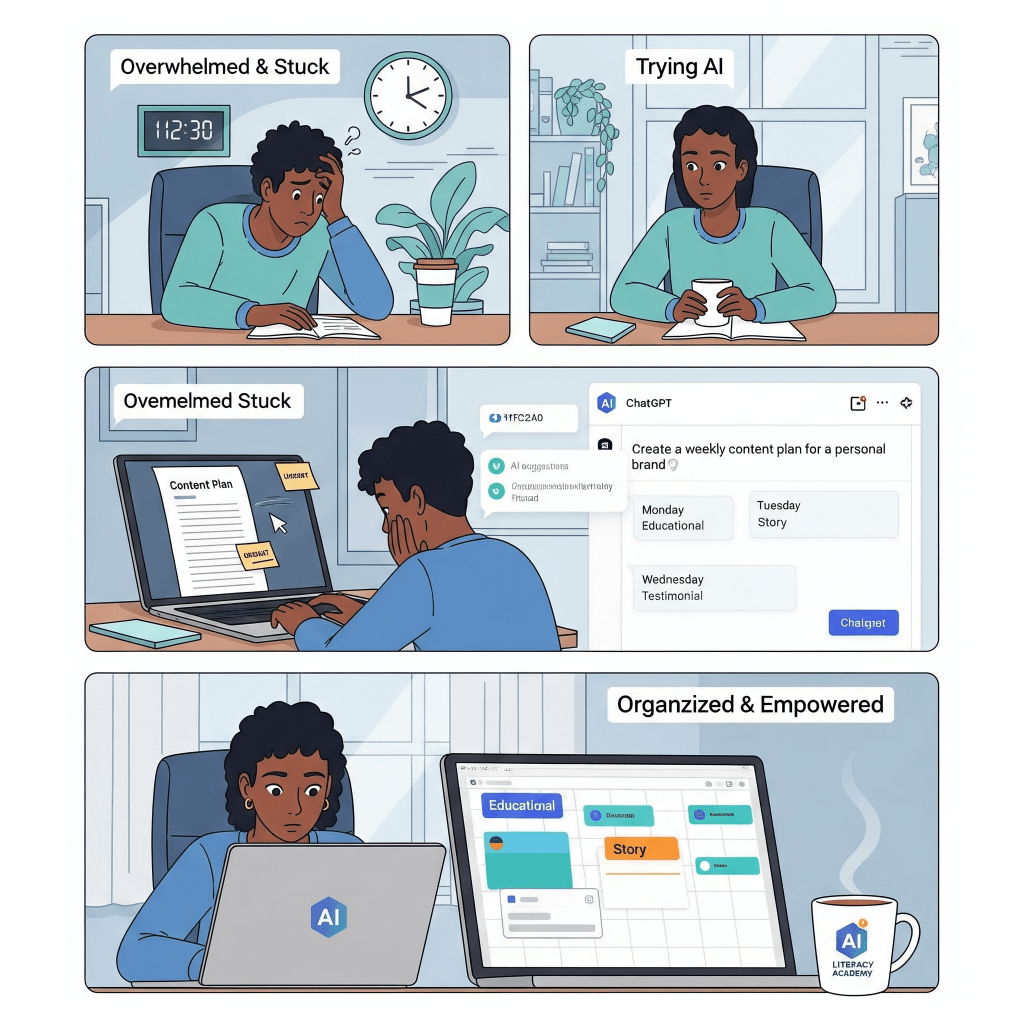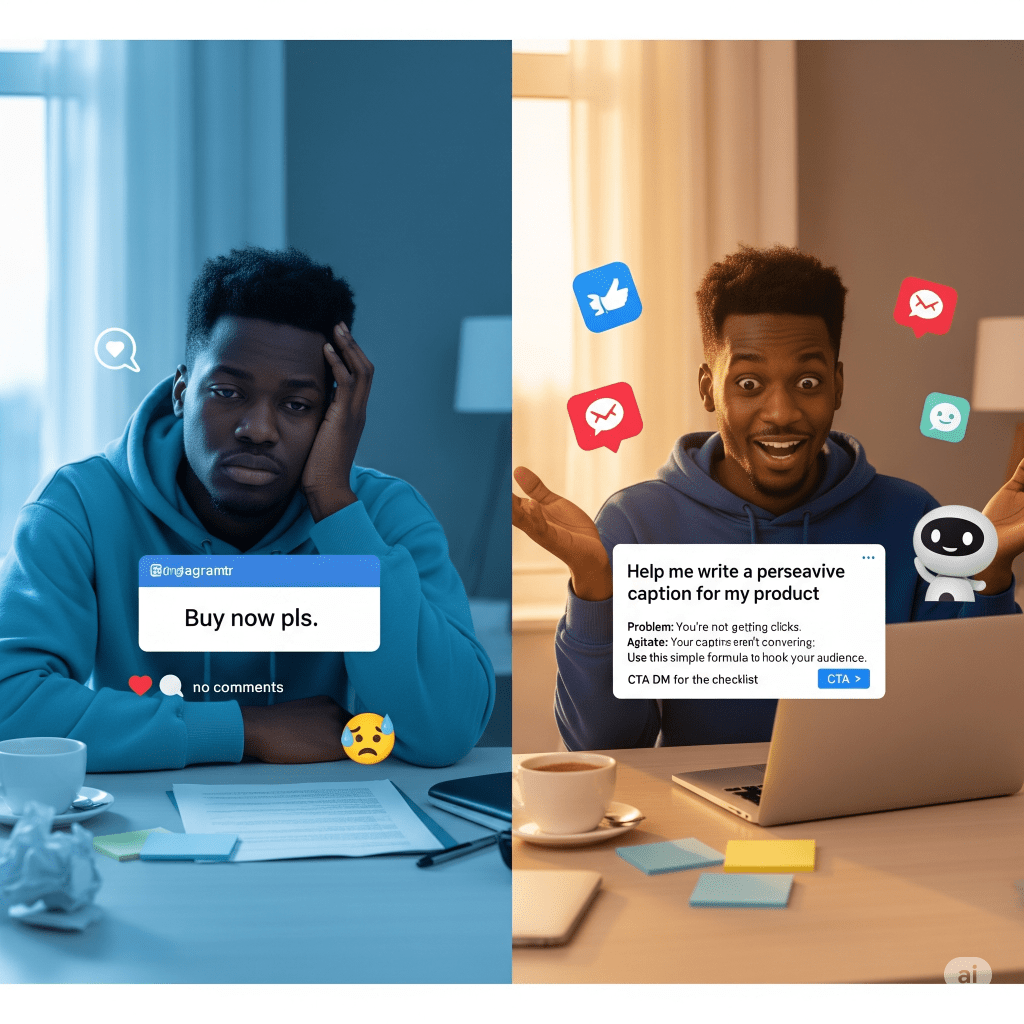Building a digital product used to mean you needed to be good at everything – research, writing, design, tech setup, marketing. Most people never started because it felt impossible.
Here’s what changed: AI can now handle most of these tasks with you. Not for you, but with you. Think of it like having a research assistant, copywriter, and business analyst all rolled into one.
We would show you exactly how to work with AI to create, package, and sell your first digital product. You’ll see the exact conversations with AI, why they work, and how to adapt them for your situation.
The best part? Once you learn this process, you can use it to build any digital product. The skills you develop here will make every part of your business easier.
Why AI Changes Everything for Digital Product Creation
Most people think AI just writes content. That’s like saying a smartphone just makes calls. AI can research your market, analyze competitors, create content frameworks, write sales copy, and even help you price your product.
Here’s what AI handles really well: You can ask AI to research any market and get back detailed analysis in minutes. It can write your course content, create templates, draft your sales emails, and structure your entire product. AI never gets tired, never has writer’s block, and can work in any style you need.
What you still need to do: You decide what to build based on real customer conversations. You check that AI’s content actually makes sense for your audience. You make the final decisions about pricing, positioning, and strategy. Most importantly, you build relationships with your customers.
How this partnership works: You give AI clear instructions about what you need. AI does the heavy lifting. You review, adjust, and make it your own. Then you test it with real people and improve based on their feedback.
This isn’t about replacing your judgment – it’s about giving you superpowers to execute faster and better.

Step 1: Let AI Help You Find the Right Opportunity
The biggest mistake people make is building something nobody wants. AI can help you research markets thoroughly before you invest time creating.
Start with this conversation:
Open ChatGPT (or Claude) and copy this exact prompt:
“I want to create a digital product in [your area of interest]. Help me understand this market better. What problems do people in this space struggle with that current solutions don’t solve well? What price ranges work for educational products here? What formats do customers prefer – courses, templates, guides, or toolkits?”
Wait for the response, then use this follow-up prompt:
“Based on what you found, suggest 5 specific product ideas that solve real problems, could sell for $50-$300, and don’t require ongoing tech support. For each idea, tell me who would buy it and why.”
Now dig deeper into the best opportunities:
Pick the 2-3 ideas that excited you most and use this prompt:
“Let’s focus on [specific product idea]. Who else is selling similar solutions? What do their customers complain about in reviews? What’s missing in the current market that I could provide better?”
Make it relevant to your market:
If you’re targeting African markets (or any specific region), add this prompt:
“How would this product need to be different for [your target region]? Consider payment methods, mobile usage, local business practices, and price sensitivity. What changes would make this more successful here?”
Before you build anything, validate the demand:
Copy this validation prompt:
“Help me create a simple way to test if people actually want this product. What questions should I ask potential customers? How can I gauge real interest without building the full product first? What would tell me this is worth pursuing vs. a waste of time?”
Notice how each conversation builds on the previous one? This is how you work with AI – not single questions, but ongoing conversations that get deeper and more specific.

Step 2: Turn AI into Your Content Creation Partner
Once you know what to build, AI becomes incredibly powerful for creating the actual content. But you need to guide it properly.
Start with the big picture:
Use this content framework prompt:
“I’m creating [your validated product] for [your specific audience]. They want to achieve [specific outcome]. Create a complete content framework that takes them from where they are now to achieving this goal. Break it into logical sections that build on each other. Each section should have practical exercises, common mistakes to avoid, and ways to check they’re on track.”
Then develop each section:
For each section, use this content creation prompt:
“Let’s create the content for section 1: [section title]. My audience is [specific description]. By the end of this section, they should be able to [specific skill/outcome]. Write this in a conversational tone, include specific steps they can take today, and anticipate the questions they’ll have. Make it practical, not theoretical.”
Keep going section by section. AI will maintain consistency if you reference previous sections.
Create supporting materials:
Use this template creation prompt:
“Based on the content we’ve created, design templates and checklists that make implementation easier. What would eliminate the most common obstacles? Create actual templates I can include, not descriptions of what they should contain.”
Check your work:
Use this quality review prompt:
“Review everything we’ve created. Is it clear for someone who’s [skill level of your audience]? Does it flow logically? Are there gaps that might confuse people? What would make this more actionable?”
The key is treating AI like a collaborator, not a magic content machine. Give context, ask for specific outcomes, and build iteratively.

Step 3: Package Your Content So People Actually Want to Buy It
Even great content can fail if it’s packaged poorly. AI can help you structure everything for maximum appeal and usability.
Get the structure right:
Start with this packaging prompt:
“Help me organize all this content into a product that feels valuable and easy to use. How should I group the sections? What order should people go through them? What would make someone excited to start and confident they can finish?”
Craft your value promise:
Use this value proposition prompt:
“Based on this product, write a clear description of what customers will be able to do after they complete it. Focus on specific outcomes, not features. What transformation will they experience? Why is this approach better than alternatives? How quickly can they expect results?”
Figure out pricing:
Try this pricing analysis prompt:
“Analyze the right price for this product. Consider the value it delivers, what similar products cost, and what [target audience] typically pays for solutions. What price point would feel like a great deal while still being profitable? Should I offer payment plans?”
Make the buying decision easy:
Use this objection handling prompt:
“What concerns might someone have about buying this? Address each concern with specific reassurances. Create a guarantee that reduces risk while protecting the value of the product.”
Step 4: Write Sales Messages That Actually Connect
Most people hate writing sales copy because it feels pushy. AI can help you create messages that serve people instead of pressuring them.
Start with empathy:
Copy this sales copy prompt:
“Write sales copy for that begins by acknowledging where [target audience] is right now and what they’re struggling with. Show understanding of their situation before introducing the solution. Make it feel like advice from a trusted friend, not a sales pitch.”
Handle objections naturally:
Use this objection response prompt:
“List the main reasons someone might hesitate to buy this product. For each concern, write a response that acknowledges their worry and provides genuine reassurance. Don’t dismiss their concerns – address them thoughtfully.”
Create social proof without hype:
Try this credibility building prompt:
“Suggest ways to build credibility for this product without making unrealistic claims. What credentials should I mention? How can I present early results honestly? What guarantees would reduce risk while building trust?”
The goal is helping people make good decisions, not convincing them to buy something wrong for them.

Step 5: Set Up Simple Systems That Work While You Sleep
You don’t need complex systems to start. AI can help you choose and set up simple tools that handle the basics automatically.
Choose your tools:
Use this tool selection prompt:
“Recommend the simplest reliable tools for: accepting payments in [your region], delivering digital products automatically, sending email sequences, tracking basic metrics, and handling customer questions. Prioritize ease of use over advanced features.”
Map the customer experience:
Try this customer journey prompt:
“Design what happens after someone buys my product. What do they receive immediately? How do I guide them through the first week? What ongoing support do they get? How do I know if they’re succeeding? Create a timeline from purchase to completion.”
Plan your launch:
Use this launch strategy prompt:
“Create a launch plan that generates initial sales through genuine value, not hype. How do I prepare my network? What content should I create beforehand? How do I announce the product authentically? What follow-up keeps people engaged without being annoying?”
Step 6: Use Data to Get Better Fast
Once you launch, AI helps you understand what’s working and what needs improvement.
Analyze your results:
Copy this results analysis prompt:
“Help me understand these launch results: [share your numbers]. What’s working well? Where are people dropping off? What do these patterns suggest about improvements I should make? What should I test next?”
Improve customer success:
Use this improvement prompt:
“Based on customer feedback [share specific feedback], what changes would help more people succeed with the product? Should I adjust the content, delivery method, or support approach? What would have the biggest impact?”
Plan what’s next:
Try this growth planning prompt:
“Given what I’ve learned, what should be my next product? How can I serve my existing customers better? What new audiences might want similar solutions? What would be the logical next step to grow this business?”

Advanced: Building AI into Everything You Do
Once you’re comfortable with these basics, you can use AI for deeper business intelligence and strategy.
Ongoing customer research:
Use this research system prompt:
“Create a system for regularly analyzing customer feedback, market trends, and competitor activities. How can I stay ahead of what my audience needs? What questions should I ask in customer interviews? How do I spot opportunities before others do?”
Content strategy:
Try this content planning prompt:
“Help me plan content that positions me as the go-to expert in [your field]. What topics should I cover? What questions is my audience asking? How do I create content that educates while building trust in my products?”
Business intelligence:
Use this strategic analysis prompt:
“Set up regular analysis of my business performance. What metrics matter most? How do I identify problems early? What questions should I ask quarterly to stay on track? How do I make better strategic decisions?”
Your Next Steps: From Idea to Income

You now have the complete process for using AI to create digital products. Here’s how to put it all together:
Week 1-2: Research and validate Use AI to research opportunities and validate demand before building anything.
Week 3-4: Create content Work with AI to develop your content section by section, including all supporting materials.
Week 5: Package and price Structure everything into an attractive, valuable product with clear pricing.
Week 6: Write sales materials Create all the copy you need to sell authentically and effectively.
Week 7: Set up systems Get your payment, delivery, and communication systems working smoothly.
Week 8: Launch Release your product and start gathering feedback for improvements.
Each product you create teaches you more about your market and improves your skills. The second product will be easier, the third even easier, and so on.
The opportunity is massive: Every market needs better solutions, and AI gives you the tools to create them faster than ever before. The question isn’t whether this works – it’s whether you’ll commit to learning and applying these methods consistently.
Your first digital product is just the beginning. You’re building capabilities that will serve your business for years to come.
Ready to master AI for business success? Visit www.ailiteracyacademy.org to take your skills even further.
